(1584 products available)













































































































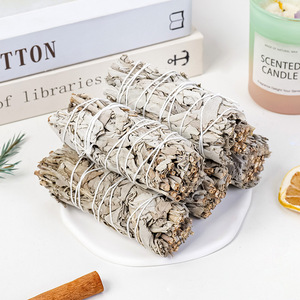
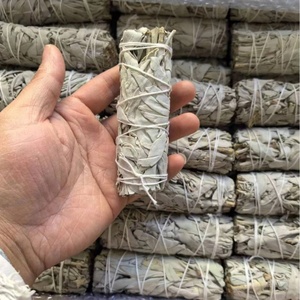
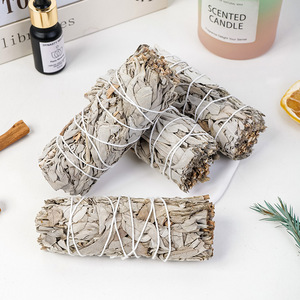
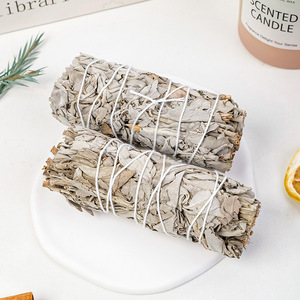
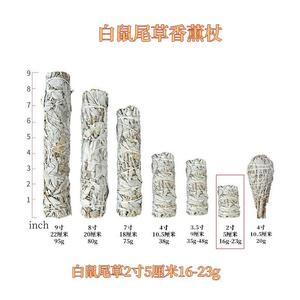



































































 Ready to Ship
Ready to ShipSage bundles are a collection of leaves from various sage plants. These can be used for different purposes, such as culinary, medicinal, and spiritual practices. Some common types include:
White sage bundles:
White sage, also known as Salvia apiana, is a perennial evergreen shrub native to Southern California and Baja California. The leaves of white sage are used to make white sage bundles. The leaves are large, light grayish-green, and covered with fine white hairs. These hairs give the leaves a soft, velvety appearance. They have a strong, earthy aroma with hints of sweetness and spice. People use white sage bundles for cleansing rituals and spiritual practices.
Desert sage bundles:
Desert sage, or frequently known as purple sage, is a common name for several species of the Salvia genus. The leaves of desert sage are aromatic and often have a green or grayish hue. People use these bundles for smudging ceremonies and purification practices.
Black sage bundles:
Black sage, also known as Salvia mellifera, is a drought-resistant evergreen shrub. It is native to California and the southwestern United States. The leaves are dark green and wrinkled, with a strong and sweet fragrance. They are used for smudging, cleansing, and healing rituals.
Common sage bundles:
Common sage bundles are made from the leaves of Salvia officinalis, a culinary and medicinal herb. The leaves are gray-green and have a strong, peppery aroma. People use these bundles in cooking and for medicinal purposes.
Culinary sage bundles:
Culinary sage bundles are made from various sage species, such as garden sage, clary sage, and golden sage. These bundles are used in cooking, especially in savory dishes, for aromatic and flavorful purposes.
Sage bundles are functional and aesthetically pleasing. Their design incorporates elements of traditional culture and modern sensibilities.
Materials
White sage is often the main ingredient. It is known for its strong cleansing properties and pleasant aroma. Sometimes, other herbs are added, like lavender for its calming effect, sweetgrass for its grounding energy, or cedar for its protective qualities. These herbs are chosen for their scent, healing properties, and cultural significance.
Crafting process
Sage bundles are made by hand. Fresh sage leaves are gathered and carefully tied together with twine or string. The artisans often use natural fibers to make the bundles biodegradable and environmentally friendly. The tying is done in a way that keeps the leaves intact while allowing them to dry without losing their shape or fragrance.
Size and shape
The size and shape of sage bundles can differ based on their intended use. Smaller bundles, sometimes called 'smudge sticks,' are made for personal use, like cleansing a person's aura or space. Larger bundles are suitable for group ceremonies or bigger spaces. The shape is usually cylindrical, with sage leaves stacked vertically within the bundle.
Aesthetic elements
Sage bundles have a rustic beauty. The green and gray tones of the sage leaves give a natural look. Sometimes, flowers or other plants are added to the bundles to make them more colorful and beautiful. Decorative ribbons or wraps are used, especially for bundles meant as gifts or for display. These aspects make the bundles more attractive but also represent their cultural and spiritual significance.
Functional aspects
The design of sage bundles makes them practical. The tied strings or twine act as handles, making it easy to hold and wave the bundle during smudging ceremonies. The drying process preserves the sage leaves and keeps their fragrance. A well-made sage bundle can last a long time if stored properly.
Spiritual practices
Smudging is a common practice in Native American traditions. Sage bundles are used to cleanse a person before a ceremony, a sacred space, or ceremonial tools. It is also used to bless new objects or people entering the community. Shamanistic practices use white sage for spiritual protection, enhancing intuition, and connecting with spirit guides.
Rituals and ceremonies
Saging is often part of rituals and ceremonies. It may include weddings, blessings, healings, and seasonal celebrations. Sage bundles are used to purify the space, participants, and objects involved, ensuring only positive energies are present.
Herbalism and natural remedies
Sage has medicinal properties in herbalism and natural healing. It can be used for respiratory issues, digestive problems, and infections. People can use sage bundles in various forms, including teas, infusions, and poultices, to provide relief.
Cooking and culinary applications
The culinary sage (Salvia officinalis) is different from the sage used for smudging. Culinary sage is used in cooking. People use sage bundles to flavor meats, sauces, stuffing, and other dishes.
Gardening and pest control
Sage is a natural pest repellent. It can keep unwanted insects away from plants. Hanging sage bundles in gardens or planting areas can help control pests without using harsh chemicals.
Odor control and air freshening
Sage has a distinctive smell. It can eliminate unpleasant odors and freshen the air. Burning sage bundles can remove the smell of smoke, pet odors, and spoiled food. It can also create a pleasant atmosphere in living spaces.
Detoxifying spaces
Sage bundles are used to cleanse spaces of negative energies. They can remove lingering energies and create a fresh start. They are often used in real estate, hotels, and wellness centers to ensure a positive environment for new occupants.
Purpose:
When choosing a sage bundle, it is necessary to know what users want to use it for. If users want to purify their home, let go of negative energy, or improve their meditation practice, white sage will be the most suitable choice. However, if users want to enhance their rituals, protection spells, or daily affirmation practices, then black sage will be better. If users want to ward off negative energy when they are out and about, then lavender sage will be the best fit.
Aroma:
Another factor to consider when choosing a sage bundle is the smell. Each type of sage has its unique fragrance. For example, white sage smells strong and earthy, while lavender sage has a sweet floral scent. Be clear about what scent will be pleasant and beneficial for users cleansing rituals or meditative practices.
Environment:
It is also vital to consider the environment when choosing a sage bundle. For example, white sage is a sacred plant for the indigenous people of California. Therefore, overharvesting this plant can lead to ecological damage. If users want to choose a sage bundle with a lower environmental impact, consider going for Louisiana or desert sage instead.
Quality:
The quality of the sage bundle is also an important factor to consider. Make sure it is handmade and tied with natural string. Good bundles should have fresh and fragrant leaves that are tightly packed together. Avoid choosing bundles that are dry, crumbling, or have brown spots on their leaves.
Size:
Last but not least, size is also an important factor to consider when choosing a sage bundle. Make sure the bundle is big enough for the user's needs but not too large as it will be inconvenient to use or store. If users are just starting out with smudging, go for a smaller bundle. The more practice users have, the larger they can go.
Q1. Can people eat sage bundles?
A1. It is not advisable to eat sage bundles. Sage bundles are made from dried leaves. They are meant to be burned for their aromatic properties. Eating them could cause digestive problems.
Q2. How long does a sage bundle last?
A2. The lifespan of a sage bundle depends on how often it is used and how well it is stored. A regularly used bundle may last a few weeks. However, if stored properly, it can retain its scent and potency for several months. Keeping it in a cool, dry place away from sunlight will help preserve its fragrance and effectiveness.
Q3. Is white sage illegal?
A3. White sage is not illegal. But it is protected in some places due to overharvesting concerns. Using white sage ethically and sourcing it from suppliers who practice sustainability is important.
Q4. How often should one cleanse with sage?
A4. The frequency of cleansing with sage depends on personal preference and the energy of the space. Some people sage their homes once a week. Others do it once a month or only when needed. Regular cleansing keeps the energy fresh and balanced.
Q5. Can people use sage bundles outside?
A5. Yes, sage bundles can be used outside. They are great for outdoor rituals, ceremonies, or gatherings. Burning sage outside helps the smoke disperse in the open air. It also keeps the area clean and free of indoor pollutants.